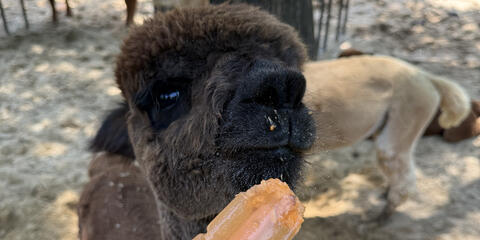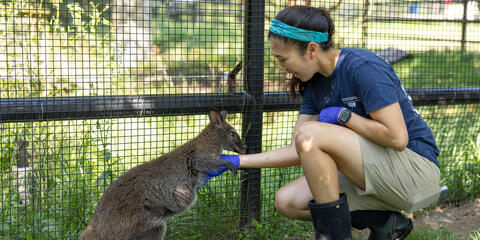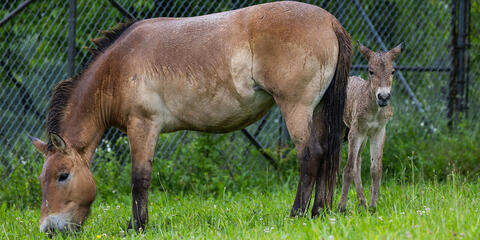Physical Description
One of four species of hyrax, rock hyraxes (also called cape hyraxes) have a short snout, cleft upper lip, short ears, and short sturdy legs. They are brownish gray with a creamy colored underside and long, black whiskers. They have a black patch of hair on their back that covers a gland; if the animal is angry or frightened this patch of hair will stand up.
The soles of their feet are rubber-like and are kept moist by a glandular secretion. There is also a hollow in the middle of the sole formed by a muscle arrangement that allows it to act like a suction cup. Both of these characteristics make rock hyraxes very agile animals that climb well and run and jump skillfully, even on rugged and steep surfaces.
Size
Adult rock hyraxes weigh 4 to 12 pounds (2 to 5 kilograms). Their head and body size ranges from 12 to 22 inches (30 to 56 centimeter) and they range from 8 to 12 inches (20 to 30 centimeter) in height at the shoulder.
Native Habitat
Rock hyraxes live throughout much of Africa and in Lebanon, Israel, Jordan and the Sinai and Arabian Peninsulas in rocky, scrub-covered areas.
Lifespan
Life span for rock hyraxes can be from 9 to 12 years.
Communication
They have very good sight and hearing.
Food/Eating Habits
In the wild, rock hyraxes primarily feed on vegetation and are grazers and browsers. They can eat plants that are poisonous to most other animals, like solanaceae and euphorbinacae.
At the Smithsonian's National Zoo, rock hyraxes eat herbivore pellets, leafeater biscuits, root and other vegetables, and greens.
Sleep Habits
They are active mostly in daylight and seldom emerge from their rocky shelters during rainy periods.
Social Structure
Some hyrax species are primarily terrestrial and active during the day. They live in colonies in "kopjes," or rock outcropping, and cliffs. These colonies can range from five to 60 individuals and may contain more than one species. When bush and rock hyraxes occur together, they live in close contact. In the early mornings they huddle together after spending the night in the same holes. They use the same urinating and defecating places.
The basic family unit consists of an adult male and several adult females and their offspring. Males may also live in bachelor groups.
Reproduction and Development
Mating season occurs about once a year. Gestation is six and a half to eight and a half months and the average litter size is three, with a variation of one to six. Young are born in crevices, fully furred with their eyes open and become mobile quite soon after birth, usually within 24 hours. They are weaned at 1 to 5 months of age and both sexes reach sexual maturity at 16 to 17 months.
Conservation Efforts
Though rock hyraxes are listed as a species of least concern, they are occasionally hunted and face some threats from human encroachment and habitat modification. They may cause damage to crops.
As land is modified, it becomes more difficult for hyraxes to find mates, food and shelter. However, they are found in many protected areas.
Help this Species
- Reduce, reuse and recycle — in that order! Cut back on single-use goods, and find creative ways to reuse products at the end of their life cycle. Choose recycling over trash when possible.
- Share the story of this animal with others. Simply raising awareness about this species can contribute to its overall protection.
Animal News

Keeping the Farm Animals Cool with Frozen Treats


